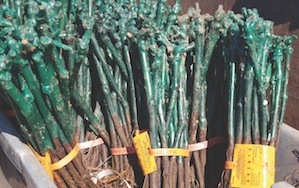_________________________________
FIRST VISITED Portugal’s Vinho Verde region in 2008 and found the wines polarised. One sort was what most people think about when Vinho Verde is mentioned: a bright, light, white wine with low alcohol, searing acidity and a slight spritz. The other sort represented the wines being made by a small band of quality minded producers such as Soalheiro, Covela and Ameal, who were looking to make more serious wines from riper grapes without any spritz. Examples would be Soalheiro’s Alvarinhos, which had quite a reputation for developing with age, and the Loureiro-based wines of Quinta do Ameal. At this time, there were very few wines that didn’t fall into these two categories of cheap spritzy or high-end bottlings.
I visited again recently and found things have changed considerably. A new style of Vinho Verde is emerging and it seems to be resonating with the demands of the market. These are single-variety Vinho Verdes without the spritz, and with alcohol levels more in line with dry white table wines from elsewhere.
“The single varietal approach that is increasingly being taken in Vinho Verde is exactly the right one,” says UK-based wine importer Nick Oakley, who focuses on wines from Portugal and northern Spain. “Single varietal Alvarinho has long been established as a premium dry white wine, yet is a million miles from the standard public perception of Vinho Verde.”
Oakley thinks the spritz and a touch of residual sugar were needed in the past when most of the vines, which were pergola trained and giving high yields, were only capable of ripening the grapes to around 9% alcohol. “These days all the modern plantations are on VSP [vertical shoot positioned trellises] and generating 11%-12% easily. I see an intermediate category emerging between the fizzy inexpensive blends made by the ocean-load in nondescript bottling halls, and the serious Alvarinhos of the Monçao and Melgaço area.”
IMPORTANT ROLE
Another important UK importer of Portuguese wines is Raymond Reynolds, and director Danny Cameron agrees with Oakley. “I think single variety Vinho Verde has an important role to play in simplifying the message of a highly misunderstood region,” he says. “And with Alvarinho, it attracts premium buyers who perhaps don’t realise they are buying from the Vinho Verde region until they read the smaller print. As the quality of these wines soars ever upwards, it can only then give more trust and confidence in the name of Vinho Verde overall.”
At the moment, the supply of varietally labelled bottlings of the region’s most famous variety, Alvarinho, is limited because only wines from the Monçao and Melgaço sub-region are allowed to put the name of the grape on the bottle. This is keeping prices high because of the demand/supply imbalance, but as the rules transition and other sub-regions are allowed to label their Alvarinhos varietally this should bring prices down a bit.
In the meantime, leading the single-variety charge are Loureiro, Arinto, Avesso and Azal. “Of these varieties we’re seeing a premium starting to develop for the Avesso grape, which is only planted in the south east of the region, on the Douro river, predominately in the Baião region,” says Oakley.




